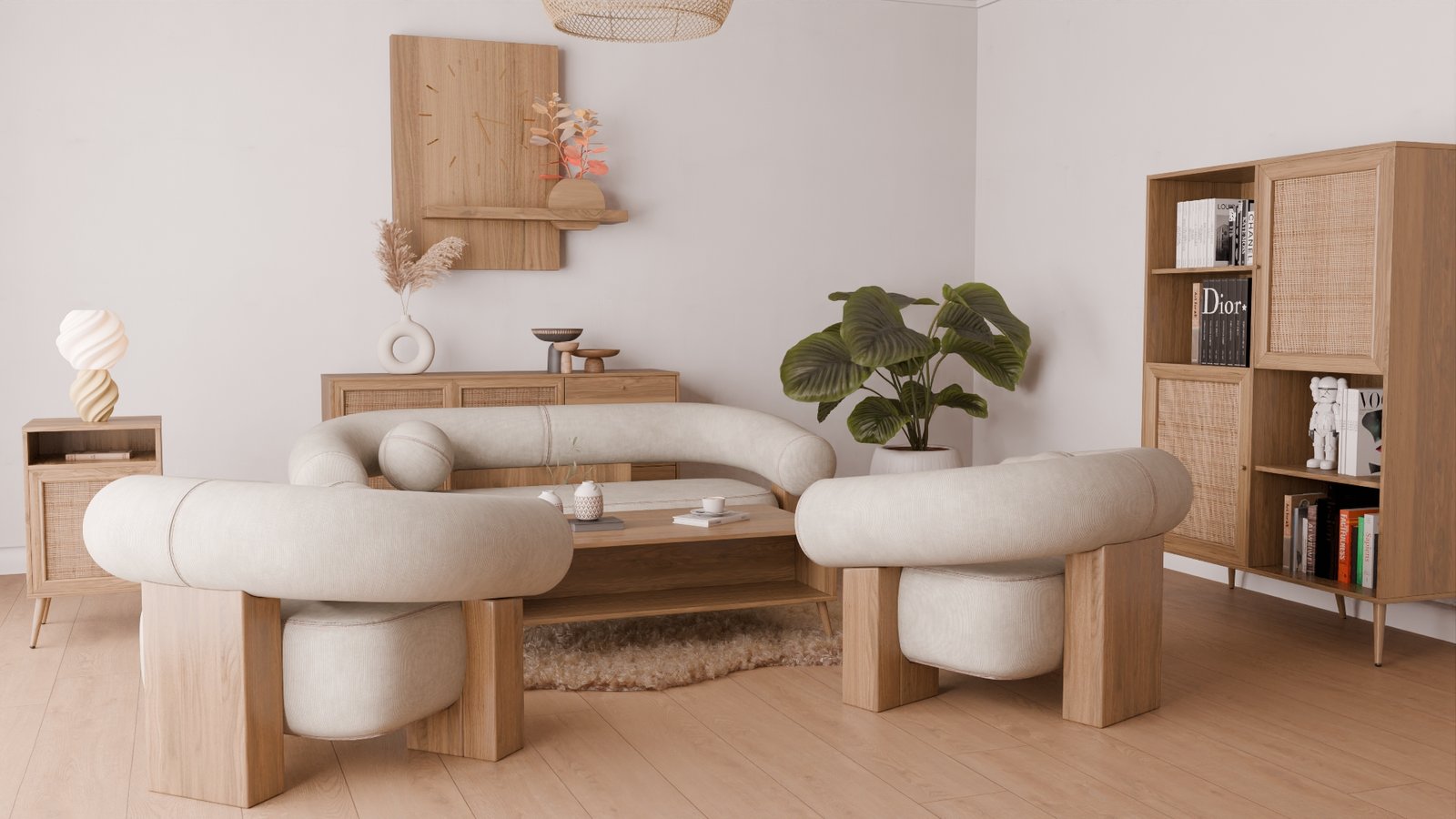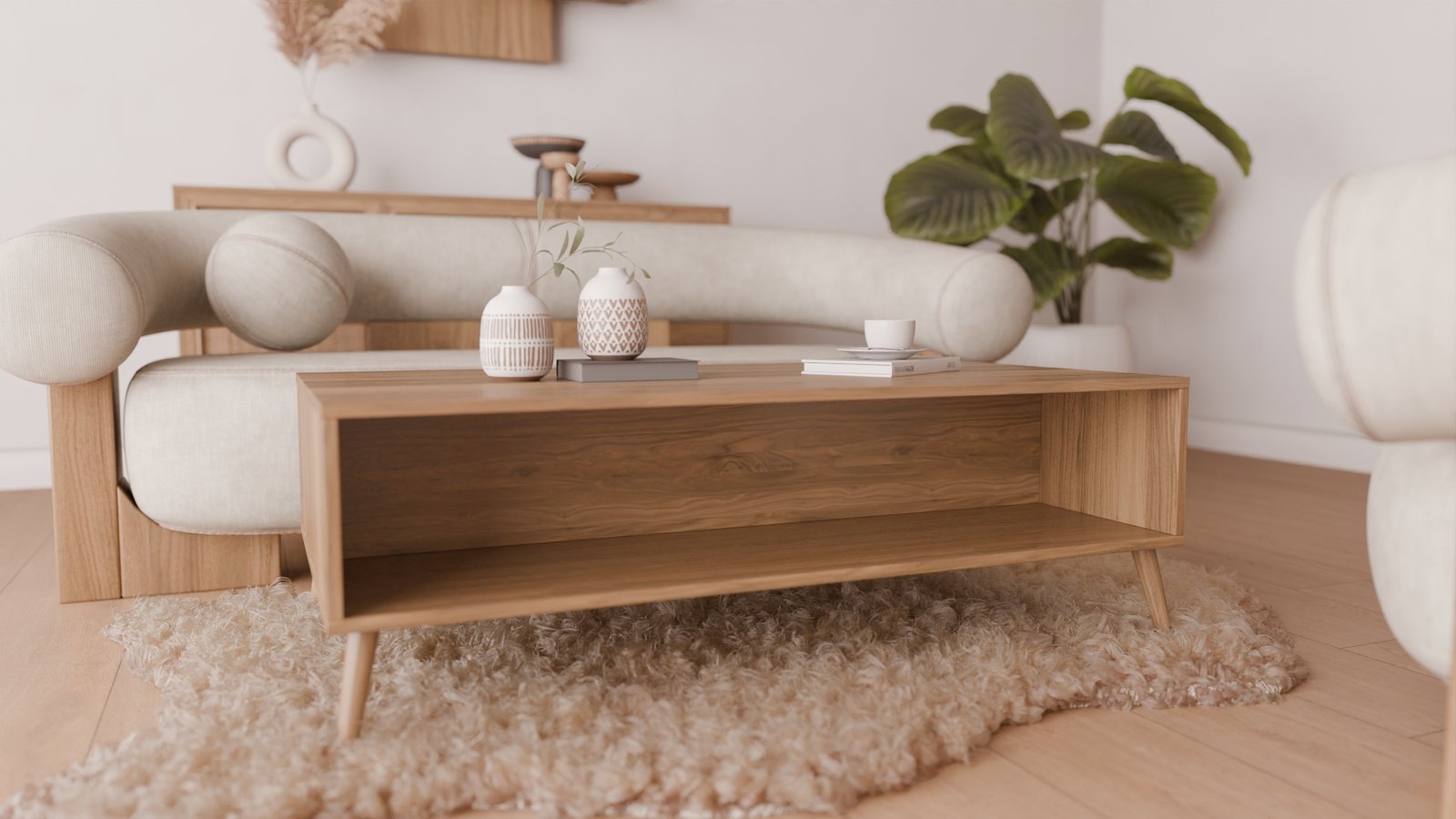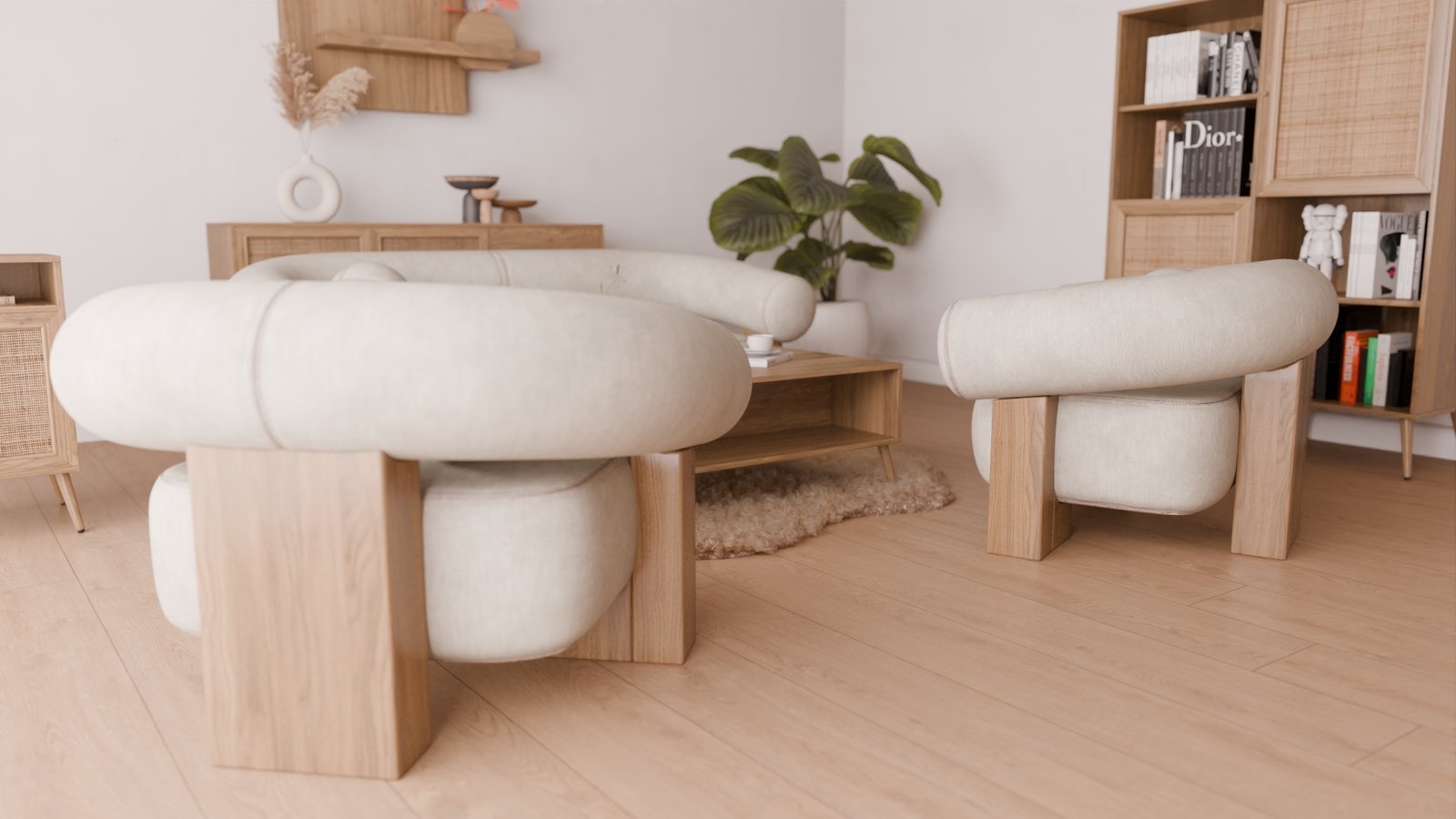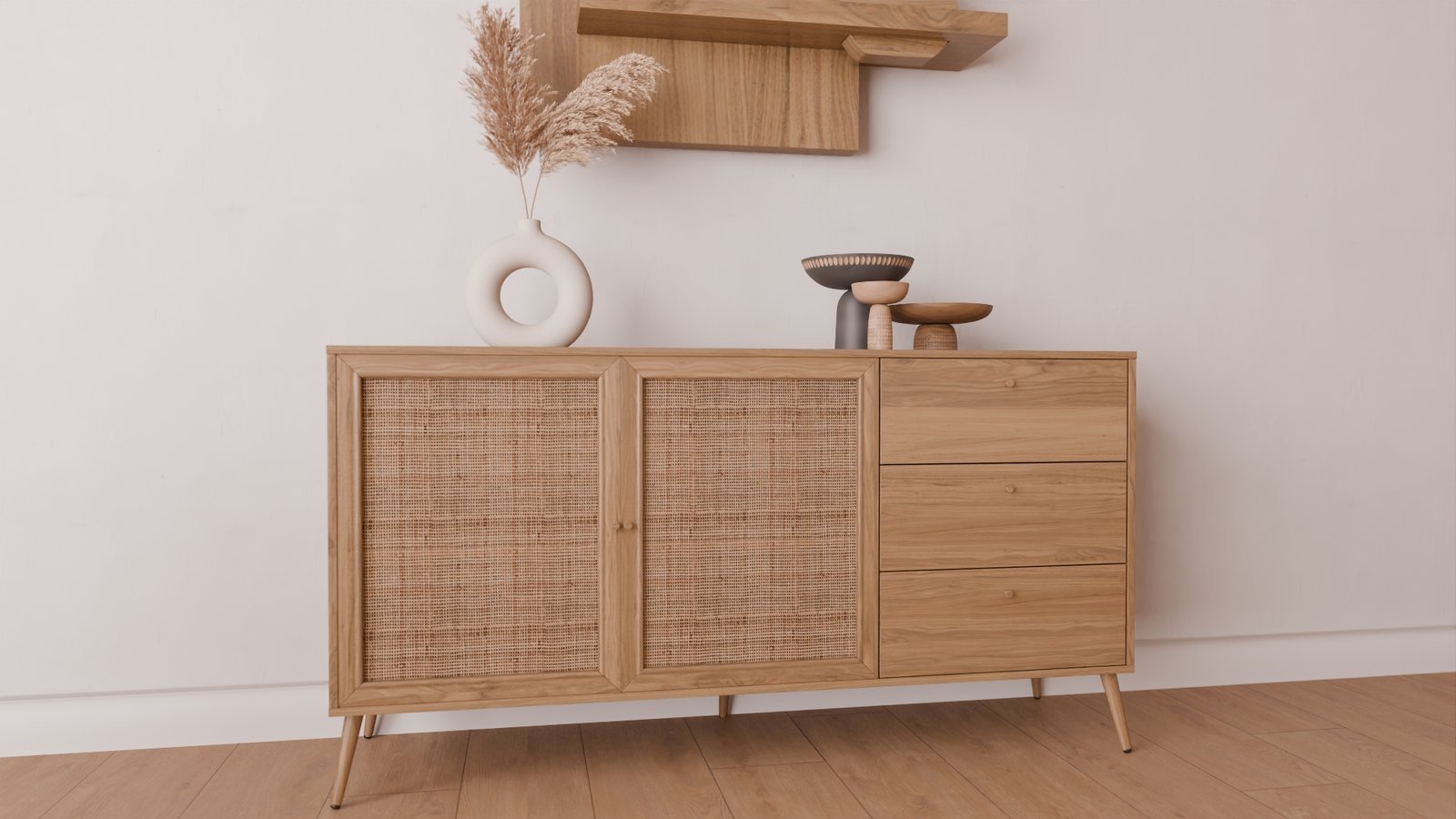How to Nail the Japandi Living Room Look

Scandi calm. Japanese soul. Clean lines, warm textures, and nothing that doesn’t belong.
We’ve styled a living room that gets it just right. Every piece plays a role. Want to know how? Let’s walk through what’s in the room, why it works, and how you can recreate the same peaceful energy in your own space without clutter, chaos, or guesswork.
Table of Contents
The Coffee Table: Light Wood, Rattan, and Breathing Room

Low round coffee table in light wood and rattan.
A Japandi room doesn’t revolve around a flashy centerpiece—it orbits around balance. This coffee table keeps things grounded without adding visual weight. Its light wood structure and woven rattan base feel natural, not fussy. And the round shape? It keeps energy moving.
Why this works:
- Soft form: Rounded edges = no harsh stops.
- Woven detail: Rattan adds texture, not clutter.
- Airy design: It fills space without crowding it.
This is the kind of table where you leave a linen napkin and a half-read book—intentional, but lived in.
The Side Table: Quiet Support

Compact side table in matching wood and rattan.
Sometimes the best pieces don’t try to steal the spotlight. This side table tucks in effortlessly—same light wood, same rattan accent—but its smaller scale makes it more of a supporting role. It’s perfect next to the sofa or even as a second surface across the room.
Why this works:
- Repeats key textures: Echoes the coffee table without duplicating it.
- Tiny footprint: Small, but just enough.
- Function meets form: Whether it holds a lamp or a tea cup, it fits.
It doesn’t beg for attention—it just quietly does its job.
The Sofa Cassete: Minimal, but Make It Comfortable

Neutral-toned Cassete sofa with low arms and wide seat.
This sofa looks structured, but feels like a hug. The Cassete’s clean lines align with Japandi minimalism, while the plush cushions invite you to stay a while. There’s no tufting, no trim, no dramatic silhouette—just clean comfort.
Why this works:
- Low profile: Keeps the room feeling wide and open.
- Neutral color: A soft base for everything else to play off.
- Function-forward: You’ll actually want to sit on it, not just look at it.
If the coffee table is the anchor, this is the heartbeat.
The Armchairs Cassete: Echoes with Intention

Pair of armchairs in the same Cassete style.
These two armchairs mirror the sofa but stand on their own. Whether they’re placed side by side or angled slightly inward, they carry the same visual language—clean, neutral, supportive—but bring flexibility to how the room flows.
Why this works:
- Design unity: Same shape and tone as the sofa = visual harmony.
- Seating balance: Perfect for conversation without making things feel crowded.
- Weightless feel: Nothing bulky, nothing loud.
They’re like visual parentheses around the coffee table—holding space without interrupting it.
The Bookshelf: Open, Honest, and Organized

Open-frame bookshelf in light wood with rattan backing.
You might not think “bookshelf” and “Japandi” go together—but this one makes it work. Open and balanced, it leaves plenty of room for breathability. Books, a few ceramics, a plant—styled just enough to feel natural.
Why this works:
- Same wood tone: This matters more than people think. Keeping every wood surface consistent makes the whole room feel cohesive.
- Visual rhythm: It’s not packed, and that’s the point.
- Texture continues: Subtle rattan detail keeps the material language flowing.
This shelf gives you room to express yourself—but not in a chaotic way.
The Dresser: Storage Without the Bulk

Low, horizontal dresser in light wood and rattan.
Japandi loves closed storage—it lets the eye rest. This dresser stays true to that. No ornate handles. No glossy finishes. Just clean drawers, soft texture, and a visual hush that makes the whole wall feel calmer.
Why this works:
- Concealed function: Everything you need, hidden in plain sight.
- Material harmony: Same wood tone as the rest—again, consistency is key.
- Warmth, not weight: Rattan softens the geometry.
It holds a lot, but you’d never guess. And that’s exactly why it belongs here.
The Sheep Rug: Comfort, Naturally

Creamy sheep rug with organic curves.
Japandi spaces love texture—but only when it adds softness. This sheep rug is thick, plush, and shaped with subtle curves. It keeps the space from feeling too hard-edged or sterile, and yeah, your feet will thank you.
Why this works:
- Organic shape: Softens the grid of furniture lines.
- Natural fibers: You can feel the warmth.
- Understated palette: Nothing loud—just cozy.
It’s one of those details that you don’t notice first—but miss immediately if it’s gone.
The Big Calathea: One Bold Breath of Life

Large leafy Calathea in a simple pot.
Plants in Japandi spaces need to feel sculptural, not messy. A big Calathea hits the mark. Its wide, patterned leaves introduce a different kind of rhythm—lively, but still grounded. It’s not filler greenery. It’s a feature.
Why this works:
- High contrast: Green without overpowering the neutrals.
- Living balance: One strong plant > ten little ones.
- Simple pot: Keeps the focus where it should be—on the plant itself.
It’s not just decor, it shifts the whole mood of the room.
The Lueur Ondulée Lamp: The Warmest Glow

Wavy sculptural lamp in soft beige.
This lamp does more than light up a corner—it changes the atmosphere. With its gentle curves and soft beige finish, it looks like it belongs in a gallery. But flip it on, and suddenly the whole room feels warmer.
Why this works:
- Curved silhouette: Repeats the softness of the rug and tables.
- Warm light: Glows like candlelight—never harsh.
- Sculptural presence: Even off, it adds something.
And yes, Lueur Ondulée is available if you want to bring one home. Trust us—you’ll wonder how your evenings felt cozy without it.
Final Thoughts: This Room Gets Japandi Right
Here’s the thing about Japandi: it rewards thoughtfulness. You don’t need a hundred perfect objects. You just need the right ones—simple, natural, and consistent. In this room, the consistent wood tone carries the calm across every piece. The textures speak softly. The shapes keep things moving. And nothing feels accidental.
Want to create a Japandi living room? Start with one honest material. A plant with presence. A table that breathes. A lamp that glows just right.
Let everything else follow the same quiet rhythm.
